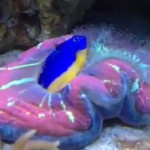Category Archives: Invertebrates

Open brain corals capable of catching and consuming live healthy fish
You seldom think about corals catching and eating your otherwise healthy fish but it might be good to know that it does happen. You might want to avoid coral species such as Trachyphyllia and other large polyp stone corals in tanks where you keep fish you really care about. The risk of something like this happening is small but ever present.
The video below shows an open brain coral in the tank of Dmitry Tumanovthat has caught and is consuming an otherwise healthy, living, large azure damsel fish. Dimitry shot this video after having lost several fish that was no where to be found.
Via reefbuilders
Giant Marine Clams
Giant Clams
For many, many years out reach for marine aquarium keepers are the giant clams, Tridacna species. And to this day. though captive raised, giant clams are not for nascent keepers.
That said they can be kept if one has the intensity and quality of lighting, a steady temperature, and natural sea water levels of minerals, and sufficient alkalinity to buffer it.
The two most common reasons why giant clams fail in aquariums are insufficient light, and predation. In the former, clams contain a symbiotic algae species in their flesh. Like most all algae (other than cyanobacteria of course), the algae that give the vivid colors of giant clam flesh photosensitize light. The wastes from that photosynthesis are sugars that feed the clam. Also, giant clams need a brisk, chaotic flow, similar to that needed for Acropora species corals.
Reef Filtration
Reef Filtration
Though in smaller reef aquariums, the organisms in live rock and sand process Nitrate, reducing it naturally to zero. In larger reefs, that is over 90 gallons in size, with more life in, filters can help in keeping it at zero
However, there are several types of filtration that can help keeping your water quality high.